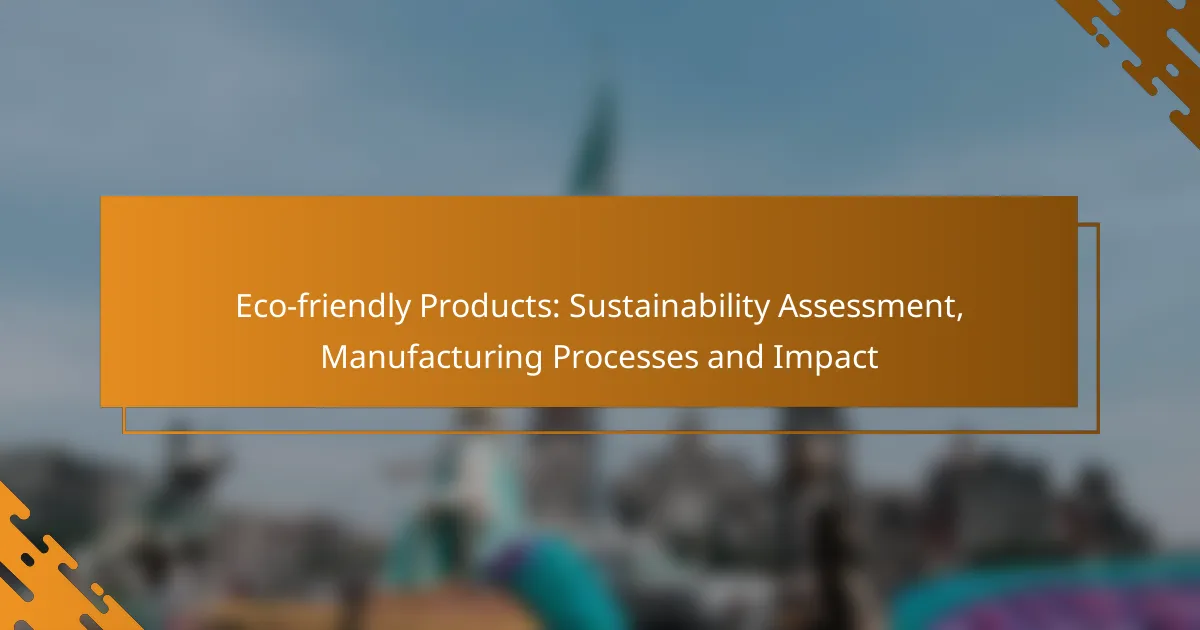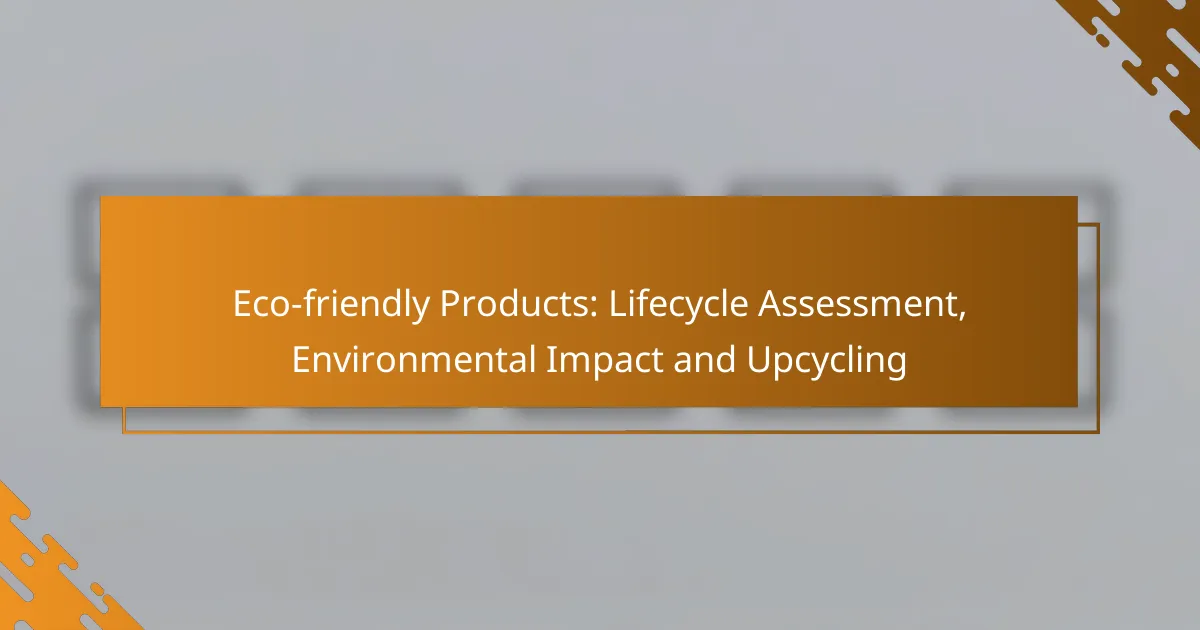Eco-friendly products play a vital role in promoting sustainable living by minimizing environmental impact while delivering practical benefits. By utilizing renewable materials and reducing waste, these products not only conserve resources but also encourage healthier lifestyles and sustainable practices throughout their design and manufacturing processes.

What are the best eco-friendly products for sustainable living?
The best eco-friendly products for sustainable living are those that minimize environmental impact while providing practical benefits. These products often use renewable materials, reduce waste, and promote a healthier lifestyle.
Bamboo toothbrushes
Bamboo toothbrushes are a sustainable alternative to plastic toothbrushes, which can take hundreds of years to decompose. Made from bamboo, a fast-growing plant, these toothbrushes are biodegradable and often feature soft bristles made from natural materials.
When choosing a bamboo toothbrush, look for brands that use organic bamboo and eco-friendly packaging. Regularly replace your toothbrush every three months to maintain oral hygiene while reducing plastic waste.
Reusable shopping bags
Reusable shopping bags are designed to replace single-use plastic bags, significantly reducing plastic pollution. These bags are typically made from durable materials like cotton, jute, or recycled plastics, making them sturdy and long-lasting.
When selecting reusable bags, consider their size and weight capacity. Opt for bags that can be easily folded and stored in your car or purse to ensure you always have them on hand when shopping.
Biodegradable cleaning supplies
Biodegradable cleaning supplies break down naturally and do not contribute to environmental pollution. These products often use plant-based ingredients that are effective in cleaning while being safe for the environment.
Look for cleaning supplies that are certified biodegradable and free from harsh chemicals. This ensures that they are not only effective but also safe for your home and the planet.
Organic cotton clothing
Organic cotton clothing is made from cotton grown without synthetic pesticides or fertilizers, promoting healthier farming practices. This type of clothing is often softer and more breathable than conventional cotton, making it comfortable to wear.
When purchasing organic cotton apparel, check for certifications like GOTS (Global Organic Textile Standard) to ensure the product meets environmental and social criteria. Investing in quality organic clothing can reduce your carbon footprint and support sustainable agriculture.
Solar-powered gadgets
Solar-powered gadgets harness solar energy to operate, reducing reliance on traditional electricity sources. These devices range from solar chargers for phones to solar-powered lights and appliances, making them versatile for various uses.
When selecting solar gadgets, consider their energy efficiency and battery capacity. Look for products with good reviews and warranties to ensure reliability and performance, especially in regions with varying sunlight availability.

How do eco-friendly products impact the environment?
Eco-friendly products positively influence the environment by minimizing pollution, conserving resources, and promoting sustainable practices. Their design and manufacturing processes aim to reduce harmful impacts, making them a crucial part of environmental stewardship.
Reduction in plastic waste
Eco-friendly products significantly reduce plastic waste by utilizing biodegradable materials or alternatives like glass, metal, or organic fibers. This shift helps decrease the amount of plastic that ends up in landfills and oceans, where it can take hundreds of years to decompose.
For instance, using reusable bags instead of single-use plastic bags can cut down on plastic consumption dramatically. Consumers can contribute by choosing products with minimal packaging or those made from recycled materials.
Lower carbon footprint
Eco-friendly products typically have a lower carbon footprint compared to conventional items due to sustainable manufacturing processes and materials. For example, products made from renewable resources often require less energy to produce, leading to reduced greenhouse gas emissions.
When selecting eco-friendly options, consider local products to minimize transportation emissions. Supporting brands that prioritize renewable energy in their production can further enhance the positive environmental impact.
Conservation of natural resources
Eco-friendly products contribute to the conservation of natural resources by using sustainable materials and reducing the demand for non-renewable resources. This approach helps preserve ecosystems and biodiversity, ensuring that resources remain available for future generations.
For example, choosing products made from sustainably sourced wood or organic cotton supports responsible farming and forestry practices. Consumers can look for certifications like FSC (Forest Stewardship Council) or organic labels to ensure they are making environmentally conscious choices.

What are the manufacturing processes for eco-friendly products?
The manufacturing processes for eco-friendly products focus on minimizing environmental impact through sustainable practices. These processes include sustainable sourcing of materials, energy-efficient production methods, and waste reduction techniques.
Sustainable sourcing of materials
Sustainable sourcing involves selecting raw materials that are renewable, recycled, or have a lower environmental footprint. This can include using organic cotton, bamboo, or recycled plastics. Companies often seek certifications like Fair Trade or Forest Stewardship Council (FSC) to ensure responsible sourcing.
When sourcing materials, consider the lifecycle of the product. Opt for local suppliers to reduce transportation emissions and support the local economy. This not only benefits the environment but can also enhance brand reputation.
Energy-efficient production methods
Energy-efficient production methods aim to reduce energy consumption during manufacturing. Techniques such as using renewable energy sources, optimizing machinery, and implementing energy management systems can significantly lower carbon emissions. For example, solar panels or wind turbines can power production facilities.
Investing in energy-efficient technologies may require upfront costs but often leads to long-term savings. Companies should regularly assess their energy use and set targets for improvement, aiming for reductions of at least 20-30% over time.
Waste reduction techniques
Waste reduction techniques focus on minimizing waste generated during production. This can include practices like recycling scrap materials, reusing packaging, and adopting a circular economy model where products are designed for disassembly and reuse. Implementing a zero-waste policy can also drive innovation in waste management.
To effectively reduce waste, businesses should conduct regular audits to identify areas for improvement. Simple strategies, such as using digital tools instead of paper or optimizing production schedules, can lead to significant reductions in waste output.

How to assess the sustainability of eco-friendly products?
To assess the sustainability of eco-friendly products, consider their environmental impact throughout their life cycle, the credibility of third-party certifications, and the transparency of their supply chains. These factors provide a comprehensive view of a product’s sustainability credentials.
Life cycle assessment (LCA)
Life cycle assessment (LCA) evaluates the environmental impact of a product from raw material extraction to disposal. This method considers various factors such as energy consumption, greenhouse gas emissions, and resource depletion. A thorough LCA can help identify stages where improvements can be made to enhance sustainability.
When reviewing a product’s LCA, look for assessments that cover multiple environmental indicators. For instance, a product may have a low carbon footprint but high water usage, which could affect its overall sustainability. Understanding these trade-offs is crucial for making informed choices.
Third-party certifications
Third-party certifications serve as reliable indicators of a product’s sustainability claims. Certifications like Energy Star, Fair Trade, and USDA Organic provide assurance that products meet specific environmental and social standards. These labels help consumers identify genuinely eco-friendly options amidst a crowded market.
When evaluating certifications, check for recognized standards relevant to your region. For example, in Europe, look for EU Ecolabel, while in the U.S., consider certifications from organizations like the Forest Stewardship Council (FSC). Ensure that the certifications are current and relevant to the product category.
Transparency in supply chains
Transparency in supply chains is essential for assessing the sustainability of eco-friendly products. Companies that openly share information about their sourcing, manufacturing processes, and labor practices allow consumers to make informed decisions. This transparency can reveal potential ethical or environmental issues that may not be immediately apparent.
To gauge a company’s transparency, look for detailed supply chain disclosures, sustainability reports, and third-party audits. Companies that prioritize transparency often provide insights into their efforts to reduce waste, improve working conditions, and source materials responsibly. Avoid products from companies that lack clarity about their supply chain practices, as this may indicate potential sustainability concerns.

What are the criteria for selecting eco-friendly products?
When selecting eco-friendly products, key criteria include material composition, manufacturing transparency, and overall environmental impact. These factors help consumers make informed choices that align with sustainability goals.
Material composition
Material composition refers to the types of materials used in a product and their environmental implications. Look for products made from renewable resources, recycled materials, or biodegradable substances. For instance, organic cotton or bamboo are often preferable to conventional cotton or synthetic fibers.
Additionally, check for certifications such as Global Organic Textile Standard (GOTS) or Forest Stewardship Council (FSC) to ensure materials meet sustainability criteria. Avoid products containing harmful chemicals or non-renewable resources, as these can contribute to pollution and resource depletion.
Manufacturing transparency
Manufacturing transparency involves understanding the processes and practices behind a product’s creation. Brands that openly share their sourcing, production methods, and labor practices are generally more trustworthy. Look for companies that provide detailed information about their supply chain and adhere to ethical manufacturing standards.
Consider seeking out products from brands that are certified by recognized organizations, which can indicate a commitment to sustainable practices. Avoid brands that are vague about their manufacturing processes, as this may suggest a lack of accountability regarding environmental and social impacts.



